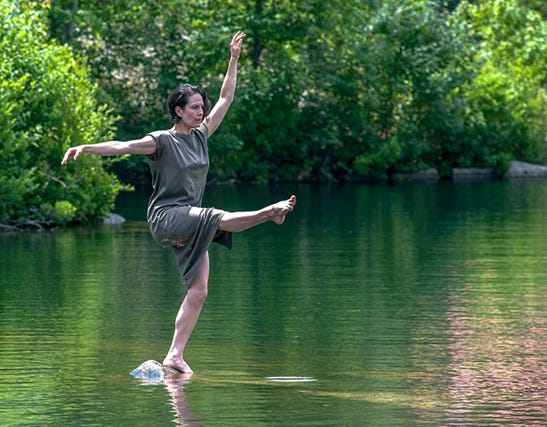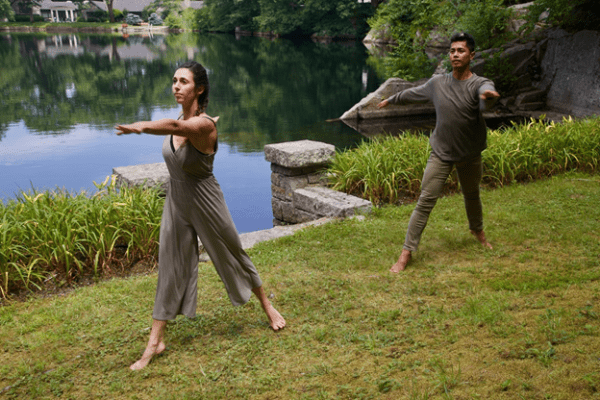Dance Review — Reclaiming Space, Quarry Dance IX
By Marcia B. Siegel
The film allowed me to see the dancers’ connections to each other, and their connections to the quarries themselves.
Quarry Dance IX on video. Dušan Týnek, choreographer. Windhover for Performing Arts Center, Rockport, MA. Streaming here
Cape Ann is especially favored by both nature and workers. Jutting into the Atlantic Ocean north of Boston, Rockport and Gloucester sit on ledges of granite that served in the construction of buildings, bridges, and roads all over the country for two centuries. When the use of steel and concrete made stone obsolete, the quarrying industry closed down. The deep pits, no longer being pumped out, filled with water from rain and underground springs. Some are almost fathomless, over 200 feet deep. Some are small backyard pits where workers dug their own “motions” in the woods.
For the past nine summers, Dušan Týnek and his New York–based dance company have come to Rockport’s Windhover Performing Arts Center to give classes and performances. They picked a different quarry each year to create a performance that’s become a big event for townspeople and guests. This year was to be Quarry Dance IX, but the pandemic prevented public attendance. Instead the dancers, one or two at a time, came to Rockport to work with Týnek, filmmaker Anders Johnson and musician Russ Gershon. Filmed at three private quarries (names withheld), the 2020 Quarry Dance has aired twice and is now publicly viewable by visiting here.
I’ve attended three or four editions in past summers. The dance changes according to the topography of each quarry. It’s tended to favor the kind of big, semaphoric motions best seen from across an expanse of water. One year a zip line was strung from one cliff to another and the dancers slid across it, sometimes dropping into the water. Another year the dancers transformed themselves into inflatable swans. But, aside from these dramatic events, what I liked best was getting into the woods and hanging out in these extraordinary landscapes.
The quarry dance on film is quite another experience. Up close, of course, you see a lot more detail. The dancers’ faces, hands, their smallest movements. But I also felt there was much more to the choreography than I’d seen before in Týnek’s quarry dances. The film allowed me to see the dancers’ connections to each other, and their connections to the quarries themselves.
The first thing in the film is the audience’s view, or the hiker’s, from one side of a quarry to the other: rock ledges with a border of trees. The camera pans along the bank, moving in. It cuts to a high sloping ledge with a dancer (Alexandra Berger) stamping on it. She’s barefoot, in low-slung tan pants and a strappy bikini top, bending over with her hands behind her back, and driving her legs into the rock. We hear a percussive drumming, tuneful but unpredictably rhythmic. Berger’s treading takes her along the ledge, back and forth. With turns and changing arms, her even stamping pattern suggests the Native Americans who lived and danced on this rocky land before it was excavated.

Alex Berger, a part of the Quarry Dance IX film. Photo: David Watts Jr.
The film cuts to show a male dancer (Gary Champi) just on the other side of the same ledge. Back-to-back across the ledge, they mirror each other. He shares her movement vocabulary but they’re not always in unison, and they don’t imitate the music’s beats. Suddenly they both come to a full stop and the camera switches to a longer view of them on top of the ledge. They resume dancing.
Next we see Champi from below, dancing a similar phrase. You can’t see his feet, but there’s a fringe of grass at the edge of the rock and the music is more melodic. Next thing, he’s dancing with another woman (Jessica Cipriano). I’m not sure if it’s the same place, but they too seem to be dancing on grass, not rock. You can feel the softness under their feet. Face to face, their intense eye contact binds them together. Even when they turn away from each other, they stay in close unison, connecting by the mysterious radar that dancers have. A quarry with low grassy banks appears behind them when the camera looks over their shoulders.
With the next cut, Cipriano is splayed against a pile of rocks taller than she is. Grout, the discards from the quarrying process, can be blocks as big as a car or slabs as small as a pillow. Cipriano stretches and angles along the rocks, leaning luxuriously while in precarious balance. Her arms and legs stretch straight out, echoing the angular blocks of granite. From above, sunlight spills down. We see treetops and hear birds calling. After five minutes or so, a man’s head appears at the bottom of the frame. His arms reach out and he lifts her off the rock pile.
In the next scene, Champi and Cipriano are found in a more manicured space, a sunlit lawn with a retaining wall of carefully cut rectangular stones, and two steps going into the water between low pillars. To an upbeat marimba-like riff, they dance side by side just inside the stone portal as if it were a proscenium.
At the base of an extraordinary pyramid rock, Champi, Berger, and Týnek leap and pivot back and forth on a sloping ledge. Then Berger levitates on one leg surrounded by water. The rational part of me thinks there must be something under the water that she’s standing on. She starts to walk, one cautious step at a time, holding up the hem of her shift. The water gets deeper around her thighs, then shallower.
Just as she steps up the bank, the film cuts to Liz Hepp leaning against a pine tree. Slowly she swings from a low branch, then ventures across a high ledge. When the camera moves behind her we can see a big quarry the size of a lake. Hepp balances and rolls on the ledge, savoring the breeze and the warm rock surface. Balanced on another pine branch over the water, then draped over the edge, she seems mesmerized. She makes her way down the side of the rock and topples backwards into the water. Refreshed, the camera repeats her splashdown.
Next, Champi and Cipriano are found in a sheltered space. The camera looks at a high shrubby bank, a sheer rock wall, and a low shelf just above the water line. Champi hangs from the cliff, drops and whirls across the ledge before toppling into the water and out of the frame. Cipriano emerges instead, arms lashing as if she’s doing a backstroke. She steps out of the water and echoes Champi’s moves across the ledge, scrambling onto the bank and pulling herself up the cliff face. She splashes into the water. They alternate the phrase twice, emerging from the water, crossing the ledge, clambering up the cliff, falling backwards into the pool.

Gary Champi and Jessica Cipriano, part of Quarry Dance IX film. Photo: Anders Johnson and Peter Van Demark.
When Champi emerges next, he’s in a different place. On his side, he pulls himself up a slanted rock. We hear loud flapping and fluttering sounds, like a flock of birds taking off.
There’s a kind of recapitulation: couples dance (Champi with Berger and Cipriano in turn) facing outward, in different locations, to a fast rhythm on hand drums and a high-pitched piping. After a few angular and stretched-out moves, another couple in a different place takes over to continue the phrase.
The camera cuts back and forth a few times, then heads back into the water. Champi and Hepp rise without moving, like fabulous deities. Half out of the water, they splash and make swimming strokes but don’t move from their spots.
After a break, we’re looking at Champi’s face and arms close up, from above. His hands grope along a rock surface. Panning along the surface, the camera finds Berger inside another rock crevice. They could be trapped inside the grout pile.
At the last, Berger stands in front of a high rock face that the camera scans from the water. Imperceptibly, Berger multiplies until there are seven of her, standing in place, making shapes that echo the jagged and slanting designs left by the quarry workers.
The more I looked at this film, the more I enjoyed its evocation of scenes I’ve loved. Maybe by next summer we can all be back in and around the quarries, but Windhover’s Lisa Hahn, Týnek, Johnson, Gershon, and the dancers have given us an apt winter’s meditation in the meantime.
Internationally known writer, lecturer, and teacher Marcia B. Siegel covered dance for 16 years at the Boston Phoenix. She is a contributing editor for the Hudson Review. The fourth collection of Siegel’s reviews and essays, Mirrors and Scrims—The Life and Afterlife of Ballet, won the 2010 Selma Jeanne Cohen prize from the American Society for Aesthetics. Her other books include studies of Twyla Tharp, Doris Humphrey, and American choreography. From 1983 to 1996, Siegel was a member of the resident faculty of the Department of Performance Studies, Tisch School of the Arts, New York University. She has contributed two selections to Dance in America, the latest edition in the Library of America’s “Reader’s Anthology” series.
Tagged: Dušan Týnek, Lisa Hahn, Marcia B. Siegel, Quarry Dance IX, Russ Gershon

I haven’t read any criticism of all the solo (and larger) dance I’ve seen but yours. Bravo! You made it seem quite wonderful.
I believe if you look to my website you will find the book I wrote which is (in the beginning) about Limon, but eventually becomes a different story altogether. It is The Misbegotten.
Thank you for your beautifully written rendition of the most recent quarry dance. Without having watched it, yet having seen a previous live version, I was loving how you put the rigidity and fluidity of dance into words. Now I will watch and I will have such a greater appreciation for what I’m seeing.
Pam Goodspeed
Gloucester
Great review!! I loved the film too.
It was so interesting to see the dancers up close and get a sense of the artistry in the movements and music from a different perspective this year.
A very different experience from being there live. I thoroughly enjoyed the film version, and was happy not to miss an opportunity to see Quarry Dance.